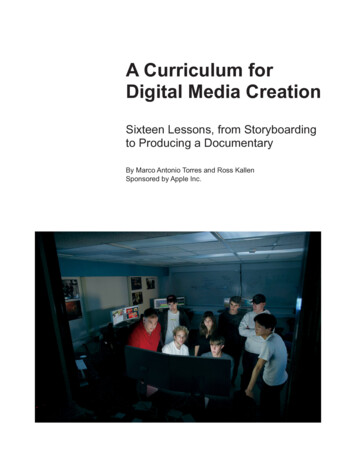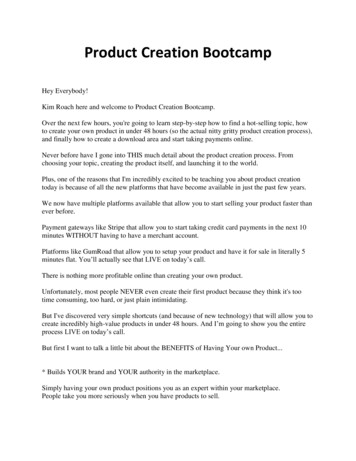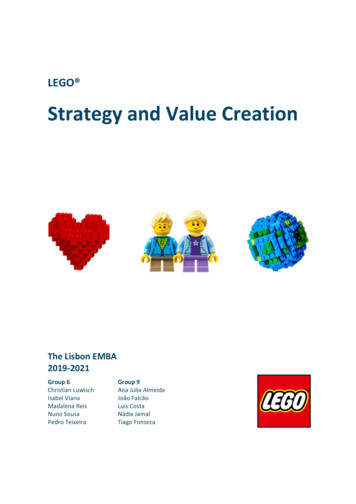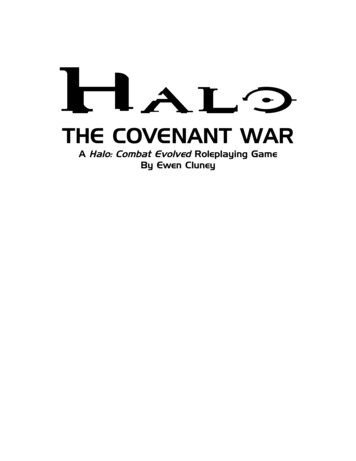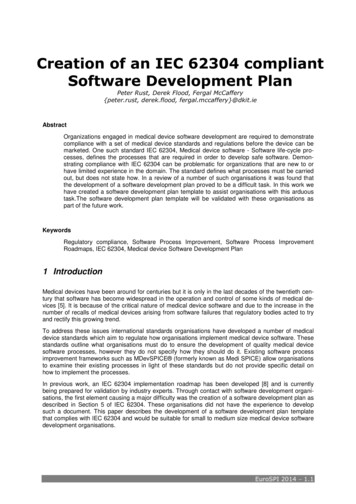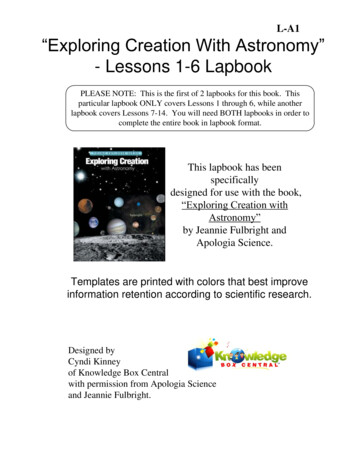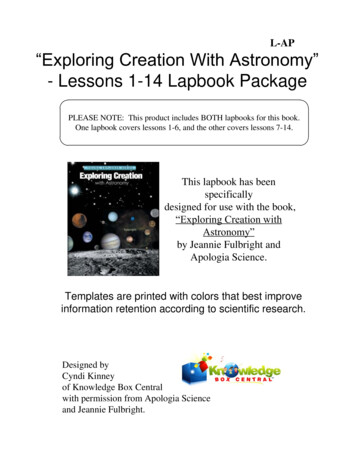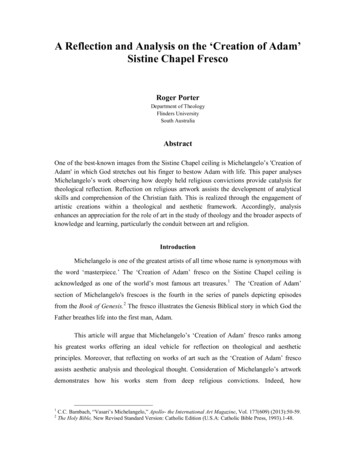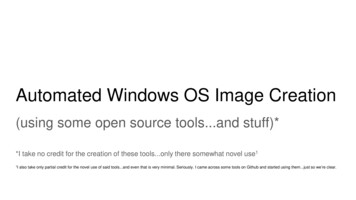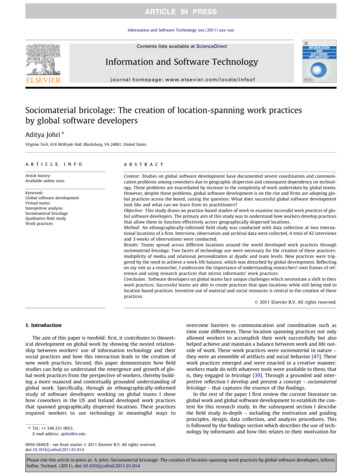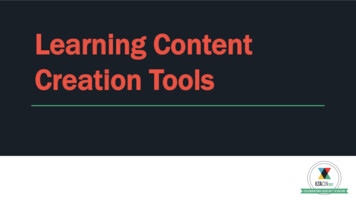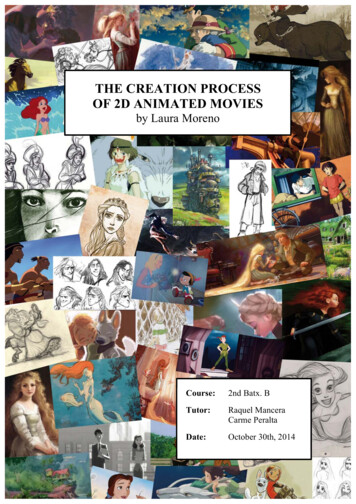
Transcription
THE CREATION PROCESSOF 2D ANIMATED MOVIESby Laura MorenoCourse:2nd Batx. BTutor:Raquel ManceraCarme PeraltaDate:October 30th, 2014
INDEXINTRODUCTION . 1 1. ANIMATION, WHAT’S THAT? . 4 2. A LITTLE BIT OF HISTORY . 5 2.1. Beginnings . 5 2.2. Early animation devices . 6 2.2.1. The magic lantern . 6 2.2.2. Thaumatrope . 6 2.2.3. Phenakistoscope . 6 2.2.4. Zoetrope . 7 2.2.5. Flipbook . 7 2.2.6. Praxinoscope . 7 2.3. A timeline (1887-2014) . 8 3. TYPES OF ANIMATION . 12 3.1. Traditional animation . 12 3.2. Stop motion animation . 12 3.3. Computer animation . 13 4. 12 PRINCIPLES OF ANIMATION . 14 4.1. Squash and Stretch . 14 4.2. Anticipation . 15 4.3. Staging . 15 4.4. Straight ahead action and pose to pose animation . 16 4.5. Follow through and overlapping action . 16 4.6. Slow-out and slow-in . 17 4.7. Arcs . 17 4.8. Secondary action . 17 4.9. Timing . 18 4.10. Exaggeration . 19 4.11. Solid drawing . 19 4.12. Appeal . 19 5. CREATING AN ANIMATED MOVIE . 21 5.1. Personal note . 21 5.2. Character introduction . 21 5.3. Finding inspiration . 21
5.4. Developing the idea . 22 5.5. Writing the script . 22 5.6. The production plan . 23 5.6.1. Delivery date . 23 5.6.2. Preliminary schedule . 23 5.6.3. Crew plan . 23 5.6.4. Budget . 23 5.6.5. Recruiting . 24 5.7. Research . 25 5.8. Designing . 26 5.8.1. Character designing . 26 5.8.2. Main location designing . 28 5.9. Composing . 28 5.10. Storyboarding . 29 5.11. Concept art . 30 5.12. Recording the dialogues . 31 5.12.1. Casting . 31 5.12.2. Character presentation . 31 5.12.3. Recording . 32 5.13. Animating . 32 5.13.1. Key animators . 32 5.13.2. Inbetweeners . 34 5.14. Inking and coloring . 34 5.15. Backgrounds . 35 5.16. Photography process . 36 5.17. Computer effects . 36 5.18. Sound . 36 5.19. Release day . 37 6. MY PERSONAL PROJECT / EXPERIMENTING THE ANIMATION PROCESSON MY OWN . 38 6.1. Sources of inspiration . 38 6.2. Developing the idea . 39 6.3. Writing my own script . 40 6.4. Research . 44 6.5. Designing process . 46
6.6. Storyboarding . 48 6.7. Recording the dialogues . 49 6.8. Animating . 51 6.9. Sound . 53 7. CONCLUSION . 54 8. WEBOGRAPHY . 57 8.1. Videos . 58 9. BIBLIOGRAPHY . 61 10. ANNEX . 62 10.1. One animation studio: Ghibli Studio . 62
INTRODUCTIONI have loved animation since I was a little girl.I used to watch a lot of animated movies and cartoons when I was young.Every time I saw a scene, a pose or an expression from a character that I reallyliked, I would pause it and try to copy it into my sketchbook. Although that reallyannoyed my sisters, who were watching tv with me, it helped me become a betterartist and in a way, that's how I discovered what I wanted to do for the rest of my life.Animating.Of course, as I was very young, I didn’t know how those movies that I lovedso much were made. When I discovered it I was amazed. I couldn’t believe how hardanimators had to work to create just one single movie.What basically made me want to do this project about animation was aconversation I had with a group of friends some time ago. We were discussing howdifficult it might have been to make a certain movie that was in theatres at thatmoment. In the middle of the conversation, one of them said: “Well, obviously it ismuch more complicated to do a live action movie than an animated one. Animatedmovies are for kids, they must be so easy to make ” She thought that cartoonswere automatically produced by computer.That made me think. How many people might think like her? How manypeople didn’t know how hard it is to animate something? I suddenly felt the urge tocorrect her and tell her how wrong she was. I needed to spread the word and tell thepeople how animation movies are truly made. This research project was the perfectopportunity to do so.Although making this project in Catalan would have been a lot easier for me, Ichose to do it in English. Basically, I wanted to know the official vocabulary andterms animators use without translating them. Also, I have always dreamed ofstudying at least one university course abroad, so I thought this could be a goodpractice before I went to college.I decided to focus my project on 2D animation because everyone had told meto work on something that was more specific than just animation in general. AlthoughI love 3D animated movies, I thought that it would be better to follow their advice.The main purpose that I had in mind when I started this project was to makepeople value more those movies that they considered “for children” or “little kids”. Idecided that if I made at least one person change their minds about animatedmovies or cartoons, this project would have been worth it.The creation process of 2D animated movies1
I started doing some research. I went to the library and picked out differentbooks about cinema and animation. I downloaded more books from the internet, too.I also looked for random information about 2D animation, as much as I could. Icopied everything that I found interesting in a small notebook and started planninghow I’d like to organize my project.I spent a lot of days of my summer holiday just watching videos and morevideos about the process of creation of animated movies, pencil tests from differentanimators, tutorials, documentaries, etc. While I was watching them, I wrote as muchas I could down.I started to think of what could I do for the practical part of my project. I didn’tthink I would be able to create a whole animated short film because I had neveranimated before and I knew it would take me a very long time.As I wanted to focus my project on the way animation studios create theirmovies, I thought it would be a good idea to pretend I was a worker on any of thosestudios and follow the same steps as they do to produce one of their films. I decidedI would try to apply all the process professionals follow in a more simple way to seewhich were the perks and drawbacks of each one of the steps.Once I had collected all the information I wanted to include in my project, Istarted to plan and develop my own animation. As you will read later, I had a lot ofdifficulties during this process but I managed to solve everything in one way oranother.I have divided this project in seven parts. The first one is a little introduction ofthe general concept of animation. The second part focuses more on its history andevolution through time. Next, I talk about the three main types of animation and Iexplain its twelve principles, which were created by Disney employees. After thatintroduction, I describe how big studios like Ghibli or Dreamworks create theiranimated films. Finally, I explain my own experience trying to animate and I sum upmy thoughts on the whole project in the conclusion section.As I have mentioned before, the main sources of information I used to createthis projects have been books, different online sites and a lot of videos from theInternet.I hope you all enjoy my project as much as I did doing it.The creation process of 2D animated movies2
The creation process of 2D animated movies3
1. ANIMATION, WHAT’S THAT?If you look up the verb “to animate” in the dictionary, you find two definitions.According to the Oxford dictionary, to animate something or someone means to give(a film or character) the appearance of movement using animation techniques. Thesecond definition -and my personal favourite- describes the action as the capacity tobring to life.To portray the mentioned “appearance of movement”, we need to create asequence of images -drawn, painted or produced by other artistic methods- thatslightly differ from one another. The chronological display of the previous images willproduce the illusion of shape change and motion. Although it may seem easyexplained in this way, in fact animation is much more complicated. It requires hardwork, perseverance and a lot of time.Over the years, animation techniques have changed and evolved; going fromsimple devices that simulate movement with a couple of frames to moresophisticated ones capable of creating complex 3D animations.Animation is all around us, it plays a very important role in our modernsociety. It is a way of communication and can be used with many different purposes;such as advertising intent (as we can find on television commercials today), didacticintention (like some educational videos or documentaries online) and also as asimple way of entertainment (referring to kids cartoons and movies).Animation is almost magical. It gives animators the capacity to createcharacters out of drawn lines and sketches. By animating, they’re able to bring thosedrawings to life and give them a personality, a backstory, a purpose And, even ifjust for a moment, they become real.Animation has been part of our life for a long time. We have all grown upwatching different animated cartoons and movies. When we were kids (or evennow), we used to suffer when our favourite characters were in danger or laughedwhen they were happy, cried when they died We used to lived their stories withsuch intensity we forgot that behind that specific movie we used to like, there was awhole team of animators that had spent weeks or even years working really hard.We momentarily forgot those characters were just drawn lines.I believe that is what makes animation so special.The creation process of 2D animated movies4
2. A LITTLE BIT OF HISTORY2.1.BeginningsOver the years, historians have found different art samples that attempted tosimulate the sensation of movement. Obviously, they were not considered“animation” yet but it was a good start.The first attempts of animation in history canbe seen in some prehistoric cave paintings. Differentdrawings of wild animals with superimposed sets oflegs of that time have been found. Those drawingsgive the impression as if the animals were runningsomehow. However, we can also think that the reasonof the unnatural quantity of legs is that they simplywanted to change its position and didn’t have anymeans of erasing.Another early approach to motion in art is the illustration found in a 5,200-yearold pottery bowl in Shahr-e Sukhteh, Iran. Its pattern is formed by five images thatshow the phases of a goat leaping out to nip a tree.Another example is an Egyptian muralfound in the tomb of Khnumhotep at the BeniHassan cemetery. It is approximately 4000years old. The Mural shows a very longseries of images that illustrate a sequence ofevents in a wrestling match between twomen. It is a very curious wall painting due tothe fact that Egyptian hieroglyphics and art ingeneral tend to represent very static figuresbut in the mural we can easily see differentposes and postures.The creation process of 2D animated movies5
2.2.Early animation devices2.2.1.The magic lanternThe magic lantern was invented in 1650, butnobody knows who did. It is a simple slide projectorthat uses images painted or photographed on glass.Although many people believe it only produced stillimages, it actually could create the illusion of motionand do all kind of different tricks and that is why it iscalled “magic lantern”.It was commonly used for educational andentertainment purposes. The magic lantern caused a great impact on society, peoplethought it produced supernatural images. Performances with this device appealed toall classes and ages so it rapidly became the most popular form of movie imageentertainment up to the silent cinema.2.2.2.ThaumatropeA thaumatrope is a toy that was popular in the19th century. It is formed by a disk with a picturedrawn on each side that has two pieces of stringattached. When the strings are twirled quicklybetween the fingers, the two pictures seem to blendinto one.Curiously, a prehistoric thaumatrope wasdiscovered in the Chauvet Caves, France.2.2.3.PhenakistoscopeThe phenakistoscope was invented in 1841by Joseph Plateau and it is a spinning diskattached vertically to a handle. The disk has asequence of images that produce the illusion ofmovement when it is turned and it projects theanimation into any mirror.It is known that the principle of this devicewas invented by a Greek mathematician calledEuclid. That is the reason of its complicated name.The term “phenakistoscope” means “to deceive, tocheat”, because it deceives the eye by creating anoptical illusion of movement.The creation process of 2D animated movies6
2.2.4.ZoetropeA zoetrope is a cylindrical device invented in 1834 bythe British mathematician William George Horner. It is verysimilar to the phenakistoscope in terms of appearance and,as all the apparatus mentioned before, it creates the illusionof motion.Its name comes from the greek term zoe, that means“life” and tropos, which means “turning”. The zoetrope usedto be sold as a toy for many years as well as bands of paperwith cycles of drawings to use with it.2.2.5.FlipbookA flipbook is a series of combined images intended tobe flipped over to create an animated sequence from asimple small book without machine. It became very popularat the end of the 19th century and the beginning of the 20thcentury. It is one of the most simple and plain animationdevices.It is also called “thumb book” because to make theimages move you have to hold it in one hand while you flipover the pages with the thumb of the other hand.2.2.6.PraxinoscopeThe Praxinoscope is a device invented by a scienceteacher from Paris called Charles-Émile Reynauda in 1876. Itis very similar to the zoetrope. The main difference betweenthe two apparatus is that the zoetrope had slits to look throughand the praxinoscope replaced them with mirrors, so thequality of the image was clearer and less distorted. The word“praxinoscope” comes from the greek term praxis, meaning“action” and scopein, which means “to look at”.The creation process of 2D animated movies7
2.3.A timeline (1887-2014)The creation process of 2D animated movies8
The creation process of 2D animated movies9
The creation process of 2D animated movies10
The creation process of 2D animated movies11
3. TYPES OF ANIMATION3.1.Traditional animationTraditional animation (also known as hand-drawn animation, cel animation orclassical animation) is an animation technique where all the frames used to createthe illusion of motion are first drawn on paper and, consequently, done by hand.This process was the most used until the appearance of computer animation(explained below). With the evolution of technology, the traditional cel animationprocess became obsolete by the beginning of the 21st century. Nowadays, thebackgrounds and characters designs from the animators are either scanned into ordrawn directly into a computer system.Although computer technology has assisted animators in their efforts over theyears, the final result still looks like the traditional cel animation did at the beginningand it has remained essentially the same over the past 70 years. Today, there arepeople that used the term “tradigital” to describe cel animation which is assisteddigitally.Some popular traditionally animated films are Snow White and the SevenDwarfs (1937) and Pinocchio (1940).3.2.Stop motion animationStop motion animation -or stop frame animation- is a cinematic process ortechnique used to make real-world objects appear as if they were moving. Thoseobjects are physically manipulated and photographed every time after being movedbetween frames. When the sequence of images are displayed rapidly, the objectsare “brought to life”.This technique is very similar to the cel animation one, except that instead ofdrawings it uses physical objects.There are many different types of stop motion animation and they are usuallynamed after the medium used to create the animation. For example claymation -orclay animation- is a form of stop motion that uses figures made of clay, like Wallace& Gromit. Puppet animation is the one that uses still puppets, as in Coraline (2009).This technique is used in a lot of Tim Burton’s movies.Early stop motion was captured with film cameras. Animators could not seehow their work looked like until they got their film processed. If the animation was notfluid, if the set had been bumped, or the lighting was bad, the work was lost and theanimator had to start all over again.The creation process of 2D animated movies12
3.3.Computer animationComputer animation, also called CGI animation, is the technique used bygenerating animated images with computer graphics. Computer animation is brokendown into two categories. Computer-assisted animation is when traditionalanimations are computerized. On the other hand, computer-generated animation isthe one designed solely on the computer system using animation and 3D graphicssoftware.Modern computer animation usually uses 3D computer graphics but 2Dcomputer graphics are still used from time to time.Computer-generated animation is very useful when it comes to creating crowdscenes or special effects, etc.Nowadays, most animated movies are created using computer graphics.Pixar, Dreamworks or even Disney, are studios that are using this type of animationto create the majority of their movies.Some examples of computer-generated films are How to Train Your Dragon(2010), Tangled (2010), Brave (2012), etc.The creation process of 2D animated movies13
4. 12 PRINCIPLES OF ANIMATIONThe twelve basic principles of animation were developed by Walt DisneyStudios’ animators during the 1930s. Amongst them were Frank Thomas and OllieJohnston, who published them in their book The Illusion of Life: Disney Animation, in1981.Those principles came as a result of their effort to produce more realisticanimations through movement and expression of the character’s body. Theprinciples follow the basic laws of physics but also deal with more abstract issues,such as emotional timing and characters appeal.They were used as guidelines to create cartoons at that time and are still usedtoday in many animation studios, where the book The Illusion of Life has beenreferred to by some as the “Bible of animation”.4.1.Squash and StretchThis action is considered the most important of the twelve principles. It givesthe illusion of weight, volume and flexibility to the characters (and also objects) asthey move.Squash and Stretch is useful in animating dialogue and doing facialexpressions because it can be applied to simple objects -like bouncing balls- andalso more complex constructions, like the musculature of a human face.The more extreme the use of this principle is, the more comical effect it has.However, it is the most commonly used and the first technique animators learn tomaster.The creation process of 2D animated movies14
4.2.AnticipationThis principle prepares the audience for amajor action the character is about to perform (likestarting to run or jumping) and makes the mentionedaction appear more realistic.A dancer cannot just leap off the floor. Abackwards motion occurs before the forward action isexecuted. The backward motion is the anticipation.To create this principle, animators studied theanticipation almost all real actions have, for examplea golfers’ back swing or a pitcher’s wind-up. Afterdoing that, they applied it to their animations and gavethem more personality.4.3.StagingStaging is a principle which main purpose consists in directing the audience’sattention to what is important in a scene, whether that idea is an action, apersonality, an expression or a mood of the characters in the frame. In other words,staging is used to keep focus on what is relevant and avoid unnecessary details.To stage correctly, animators have to make the background and the animationwork together as a pictorial unit in a scene. Every sequence must relate somehow tothe overall story and provide information to the viewers about the characters and thelocation of the story, the historical moment, etc.This technique is also used in theatre and film. The idea of staging is findingthe effective use of different camera angles, light and shadow, the placement of acharacter in the frame, etc. to help in telling the story and developing its plot.The creation process of 2D animated movies15
4.4.Straight ahead action and pose to pose animationAnimators use the expression “straight ahead action” when they draw out ascene frame by frame from beginning to end. This technique is very useful to createfluid and dynamic illusion of movement but the animation can lose size, volume andproportions. It is used in fast, wild action scenes because it provides spontaneity andfreshness to the final result.Pose to pose is very a little bit different. First of all, animators plan out thescenes they have to develop and do key drawings at intervals that, later on, will behanded to their assistants who will fill the intervals and finish the animation.Size, volumes and proportions are controlled better this way. This methodworks better for dramatic or emotional scenes, where composition and relation to thesurroundings are of greater importance.Many scenes are created using a combination of both methods.4.5.Follow through and overlapping actionThese are two concepts that together help to represent movement morerealistically.Follow through consists in avoiding the sudden stoppage of a character andmaking all other parts of its body continue to move after it has stopped in order tocatch up with the rest of the main mass.The main purpose of the overlapping technique is to avoid any “robotic effect”and give more fluidity to the character’s movement. It is used by animators toemphasize the action and mood of the character by moving the different parts of thecharacter’s body at different speed and at different times. When it moves, someparts of the body lead the action and the others follow the main action. Normally,arms and legs follow the movement of the torso.“Drag” is another popular technique where the “following parts” of the bodytake a few more frames to catch up with its “leading parts”. For example, if aThe creation process of 2D animated movies16
character starts running, his head, ears, upper body and clothes may not keep upwith its legs. That way, it would look as if the character was running as fast as hecould.Another example we can use is the famous dance scene from Snow Whiteand the Seven Dwarfs. In it, she starts dancing but her dress doesn’t begin to movewith her until some frames later.4.6.Slow-out and slow-inThe slow-out and slow-in techniqueconsists in drawing more frames near thebeginning and the end of an action and fewer inthe middle. This way, the parts where there aremore frames will look slower and the action itselffaster. It will give the character time to accelerateand slow down and make the animation morerealistic.4.7.ArcsThis technique is based on the natural trajectoryalmost every action follows, arcs. It can be applied to thehuman figure and animals or simply to thrown objects. Arcsmake animation look more natural and have a better flow.Objects that move out of their natural arc will appearerratic. To prevent that, animators tend to draw the arc onthe paper for reference and erase it later.4.8.Secondary actionThe secondary action is an an
books about cinema and animation. I downloaded more books from the internet, too. I also looked for random information about 2D animation, as much as I could. I copied everything that I found interesting in a small notebook
